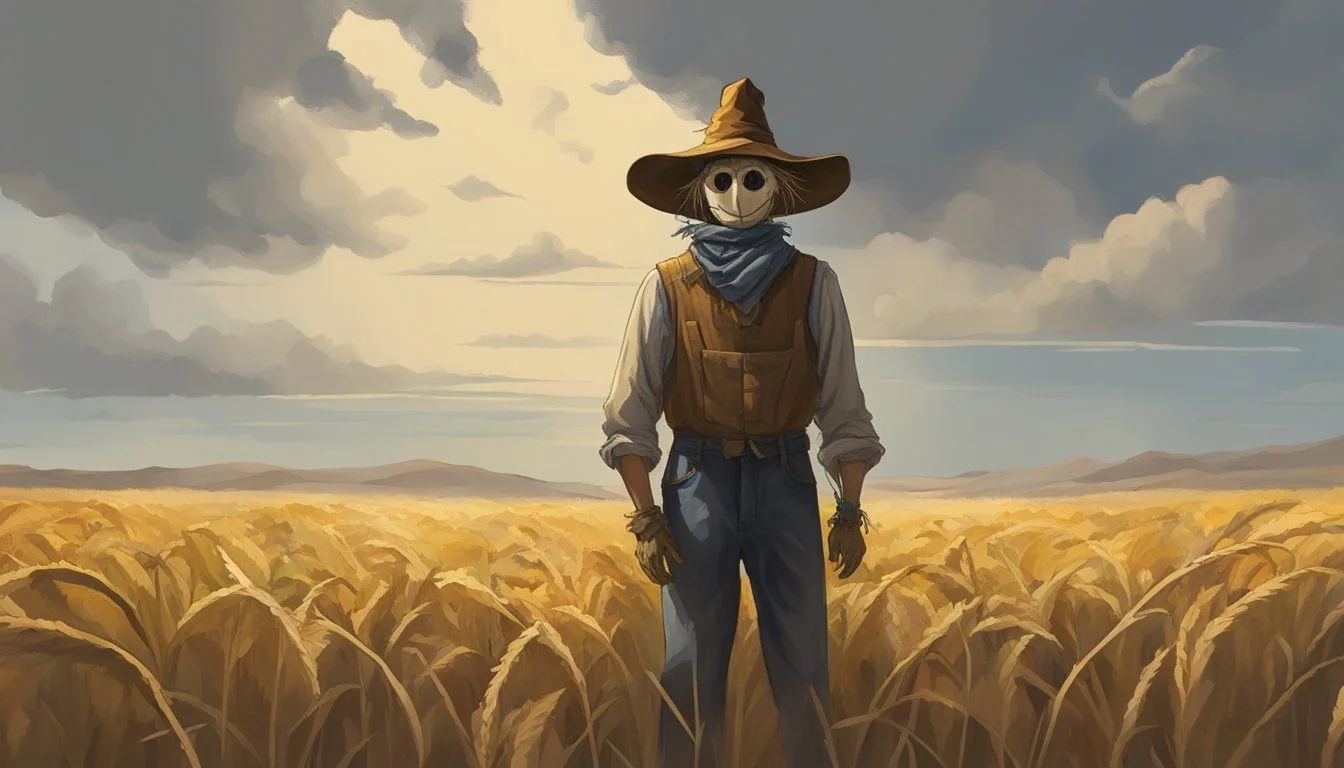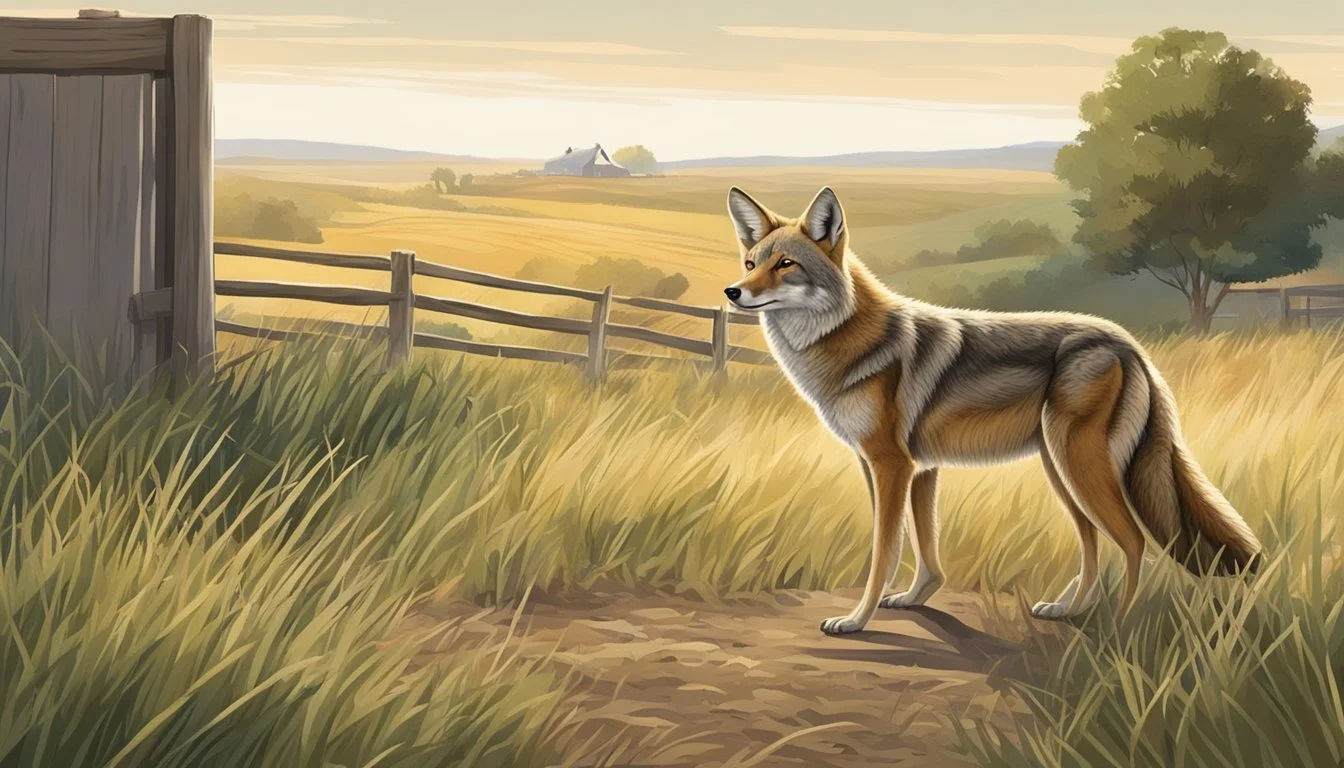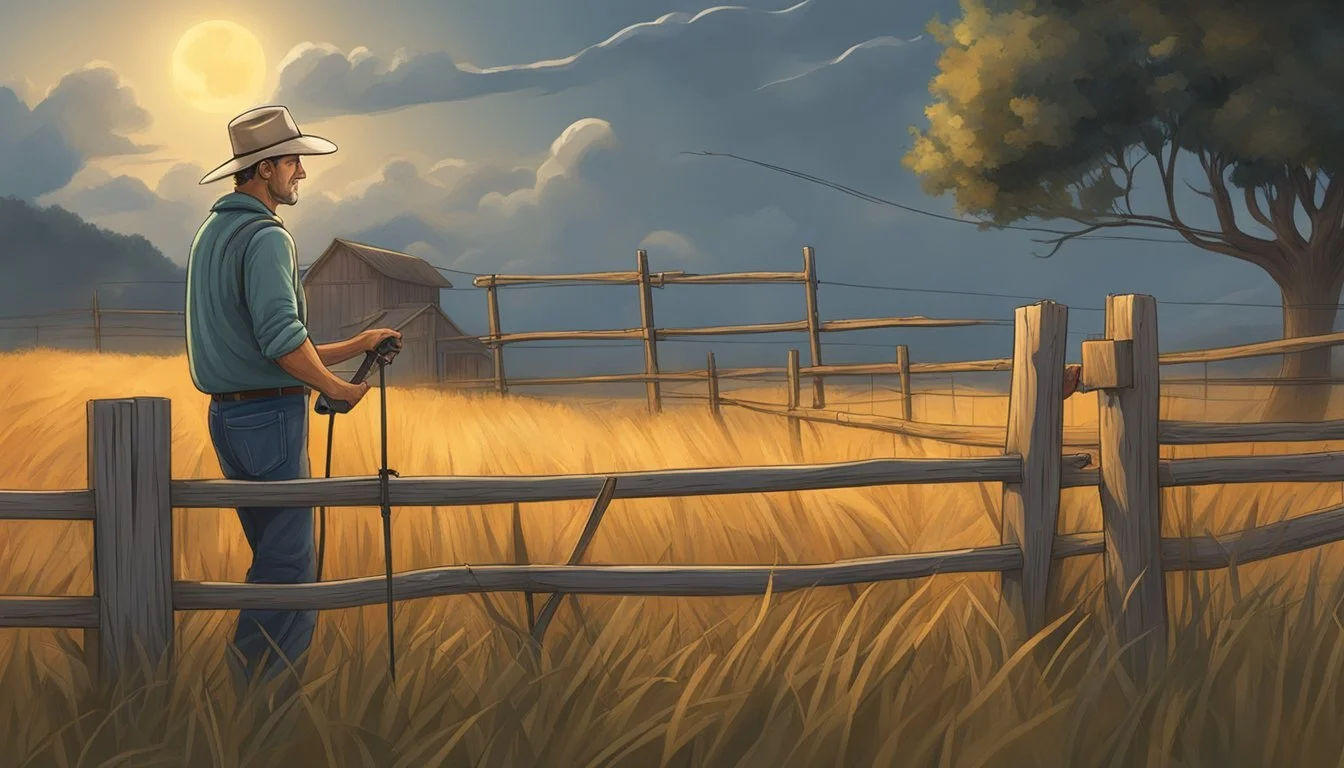Protecting Crops from Western Coyote
Effective Management Strategies
The Western coyote, an adaptable and widespread predator, has become increasingly common across North America, often bringing them into direct conflict with agricultural operations. As opportunistic feeders, coyotes may prey on livestock and damage crops, presenting a significant challenge for farmers. The task of protecting agricultural areas from coyotes requires a balanced approach that considers both the ecology of the coyote and the economic realities of farming.
Efforts to mitigate these conflicts have led to the development of various nonlethal solutions that enable coexistence between coyotes and agricultural interests. Techniques such as the use of fencing, guard animals, and changing farming practices have been studied and deployed with varied levels of success. Awareness and understanding of coyote behavior is essential in devising strategies that protect crops and livestock while also respecting the role of this keystone species within the ecosystem.
Understanding Coyote Behavior
In addressing crop protection from Western coyotes, it's crucial to understand their behavior, from territorial habits to their adaptations. Insights into these behaviors provide valuable guidelines for wildlife management.
Territorial Dynamics
Coyotes are highly territorial animals, often forming packs that defend a specific range. The pack usually consists of a breeding pair and their offspring, although size and composition can vary seasonally. Territorial vocalizations and scent marking are common ways coyotes communicate boundaries to prevent conflicts with neighboring packs.
Reproduction and Lifecycle
Reproduction is a significant aspect of coyote behavior with a mating season typically from late January to March. Litters of 5-7 pups are born in spring, in a den which offers protective shelter. These offspring are raised cooperatively by the pack, and within a year, juvenile coyotes may disperse to establish their own territories or remain with the pack.
Dietary Habits
Coyotes are omnivorous predators, with a diet that can adapt based on availability of food sources. They consume a variety of prey, including rodents, rabbits, fruits, and insects, which can occasionally include farm crops or livestock. Understanding their dietary flexibility is fundamental to developing humane and effective management strategies.
Habitat and Range Adaptations
Adaptability is a hallmark of the coyote's success. These animals have expanded their habitat to encompass a variety of environments, from deserts to urban areas. Western coyotes often occupy areas where they can exploit both natural and human-altered landscapes. Their range adaptations are influenced by available resources, disease, and the presence of other predators.
Challenges of Coyote Presence
The presence of coyotes in western regions poses significant challenges to agriculture and urban settings, with direct impacts on livestock, pets, and the interactions between humans and wildlife.
Livestock Depredation
Coyotes are opportunistic predators and can cause extensive damage to livestock, particularly sheep and calves. The economic impact of such depredation can be substantial for farmers, necessitating the use of various livestock protection strategies. Diseases can also be spread by these predators, compounding the challenges faced by livestock owners.
Threats to Pets and Small Animals
Pets and small animals are at risk in areas where coyotes roam. Cats and dogs may fall prey to coyotes, especially free-roaming cats or pets left unattended outdoors. Keeping pets indoors or within enclosed areas is crucial to minimize such encounters.
Human-Coyote Conflicts
As coyotes adapt to urban environments, incidents of human-coyote conflicts increase. Coyotes drawn to neighborhoods by trash or other food sources can become less wary of humans, leading to dangerous encounters. Effective control methods and public education are key to managing these interactions.
Coyote Expansion and Human Settlements
Coyote populations have expanded into many human-dominated landscapes, challenging the coexistence between people and this apex predator. The biology and territorial behaviors of coyotes, such as marking and defending areas, create tensions within human settlements, requiring continuous management efforts to balance survival and safety.
Preventative Measures and Solutions
To effectively protect crops and livestock from the Western coyote, it is essential to implement a combination of preventative measures and solutions based on environmental awareness and animal behavior.
Fencing and Physical Barriers
Fencing serves as the first line of defense to deter coyotes. The installation of an electric fence is an effective measure, with a minimum recommended height of six feet to prevent coyotes from jumping over. Adding a device like a Coyote Roller at the top of the fence can further prevent them from gaining a foothold. In addition to above-ground barriers, burying hardware cloth 12 inches into the ground around pens may prevent digging.
Livestock Guard Animals
Utilizing livestock guard animals is a tried-and-true coyote control technique. Dogs, donkeys, and llamas, when properly trained, act as diligent protectors of livestock. These guard animals bond with the livestock they protect and naturally deter predators, reducing the likelihood of predation.
Coyote Control Techniques
Coyote control techniques go beyond traditional hunting and trapping, focusing on integrated wildlife management approaches. For instance, employing nonlethal deterrents like noise and light can effectively haze coyotes away from homesteads. It is essential to manage food attractants, such as compost or pet food, to not inadvertently lure coyotes closer.
Community Education and Support
Finally, community education and support play vital roles in managing predation issues. Informing the public about nonlethal solutions, from primary repellents like chemical deterrents to secondary measures like property maintenance, can lead to widespread adoption of humane coyote management strategies. Engaging with local wildlife programs may also provide additional resources and support.
Legal and Ethical Considerations
When managing Western coyote populations to protect crops, it is imperative to consider both the legal frameworks in place and the ethical implications of wildlife management practices. These aspects ensure the balance between human needs and wildlife preservation.
Regulations on Wildlife Management
Each region has specific laws and regulations governing wildlife management, including the control of coyote populations. For instance, some states may offer guidance or require permits for hunting or trapping coyotes. It is crucial for farmers and landowners to adhere to these regulations to avoid legal repercussions and to participate in responsible stewardship of local ecosystems.
Ethical Trapping and Hunting
Beyond legality, ethical considerations in trapping and hunting must not be overlooked. Traps should minimize suffering with practices such as using padded or non-lethal traps when appropriate. Hunters are encouraged to pursue quick and humane methods in line with the principles of fair chase, and to recognize the potential impacts of their actions on coyote populations and behavior, an aspect often referred to as the predator paradox.
The Role of Conservation
Wildlife management includes strategies aimed at managing predation to protect agricultural resources while conserving the coyote as part of the ecosystem. The use of non-lethal deterrents and understanding coyote behavior are as essential to sustainable management as controlling their numbers. Conservation efforts help maintain ecological balance, often mitigating the consequences of the predator paradox where aggressive control measures may counterintuitively result in increased coyote populations.
Impact on Ecosystem and Biodiversity
The Western coyote plays a complex role in the ecosystem, balancing the food chain as a top predator and influencing biodiversity through its interactions with various species.
Coyotes as Apex Predators
Coyotes are considered apex predators in some ecosystems, where their absence or presence can significantly alter the ecological balance. They help control populations of various prey species, including rodents and insects, which could otherwise damage crops. Effective wildlife management practices acknowledge the role of coyotes in maintaining these population dynamics, which helps to protect resources vital for agricultural activities.
Coyote Interactions with Other Wildlife
As omnivores, coyotes have a diversified diet that includes fruits and garbage, in addition to birds, goats, and chickens. These interactions can lead to conflicts, particularly where coyotes impact livestock such as through sheep predation. However, their predation also aids in controlling numbers of smaller mesocarnivores, thus supporting coexistence strategies focused on natural means of pest control, benefitting overall biodiversity.
Biodiversity and Coyote Roles
By regulating prey species, coyotes contribute to a more varied and resilient flora, which in turn supports a more diverse fauna. Rabies transmission and pup survival rates are two factors affecting coyote populations that can have broader implications for ecosystem health. Each element within this complex web, from coyote behavior to environmental impact, is a piece of a larger puzzle in understanding how to protect crops while fostering ecological diversity and stability.
Additional Resources and Further Reading
In the quest for effective wildlife management, specifically pertaining to protecting crops from the Western coyote, a variety of resources are available. These resources provide information on prevention strategies, local agencies to contact, and insights from scientific research.
Online Platforms and Databases
Online Portals:
The USDA National Institute of Food and Agriculture offers Crop Protection Pest Management Programs providing strategic guidelines to mitigate conflicts with wildlife.
Project Coyote is an informative platform dedicated to promoting coexistence between people and wildlife through education and science.
Databases:
Extension services such as those from Michigan State University compile best practices for managing coyotes on farmlands, including various deterrent methods.
Local Wildlife Agencies
Contact Information:
Department of Natural Resources can be accessed for immediate assistance and localized advice on coyote encounters at (888) 936-7463 or through their website.
USDA APHIS Wildlife Services, reached at (608) 837-2727, provides direct services for managing wildlife conflicts.
Services Offered:
These agencies provide on-site evaluation, removal services, and advice on nonlethal methods to protect crops.
Research Papers and Studies
Scientific Literature:
Research outlining the ecological benefits of coyotes and the ineffectiveness of lethal control measures can be found in publications from Project Coyote, shedding light on alternative wildlife management strategies.
Studies that observe trophic cascade effects and their influence on agriculture are crucial for understanding coyote population dynamics and their role in ecosystems.
Research Outcomes:
Key findings include the importance of maintaining natural predator-prey relationships and employing evidence-based, nonlethal wildlife management techniques for long-term sustainability.
Frequently Asked Questions
Protecting crops and livestock from Western coyotes requires a strategic approach that utilizes effective deterrents and control methods. Farmers and ranchers can find a balance between coexistence and protection.
How can livestock be safeguarded against coyote attacks?
Livestock can be protected through the use of guardian animals, such as dogs, llamas, or donkeys, which can deter coyotes through their presence alone. Fencing, both traditional and electric, also serves as a physical barrier to coyote intrusion.
What measures do farmers implement to prevent coyote predation?
Farmers may utilize coyote-specific traps and regularly change grazing patterns to minimize the risk of predation. Additionally, the removal of attractants such as fallen fruit or unsecured garbage helps reduce coyote visits.
What deterrents are most effective in repelling coyotes from farmlands?
Effective deterrents include motion-activated lights and noisemakers, which create an unpredictable environment that coyotes tend to avoid. Some farmers also use CoyoteVest or other protective gear for smaller livestock.
Which predator control methods are recommended by the USDA for coyotes?
The USDA recommends an integrated approach to wildlife management, including exclusion, habitat modification, and when necessary, the selective removal of problem individuals in compliance with state and federal laws.
How can farmers ensure the safety of horses and cattle from coyotes?
Horses and cattle are less frequently targeted by coyotes but can be protected by secure night-time enclosures and calving in areas that are easily monitored. Regular human presence and activity on the farm can also serve as a deterrent.
What strategies are available for protecting pigs from coyote intrusions?
For protecting pigs, especially smaller breeds or piglets, sturdy enclosures with secure roofs and mesh that extends underground can prevent coyotes from digging their way in. They can also be kept near the farmhouse where there is regular human activity.







